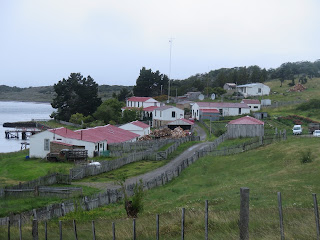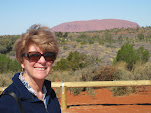Dec 12, Monday. On our way down to breakfast this morning we looked out the window and saw our local mountain covered in snow.
Then came the highlight of our Beagle cruise, an island of nesting penguins. There were two types: Magellanic Penguins (black and white) and Gentoo Penguins. We believe there was a King penguin amongst the Gentoos. Unfortunately, it then began to snow. You know you're in trouble when antarctic birds start to hunker down to keep out of the wind.
After our penguin viewing we sailed a short distance to an estancia (ranch) which was the first one established on Tierra de Fuego. It was owned by Thomas Bridge who was an orphan from Bristol England. He had been adopted by an Anglican minister, became a minister himself, and eventually benefitted from the Argentinian desire to protect territory from the Chileans.
Around 4:30 we boarded a bus to take us back to Ushuaia. Along the road we stopped to see the flat trees. These solo trees have been buffeted by southern winds so long and so often, they end up looking like the photo below.
We got back to the dock area. The guide who had been with us all day, Gaspar, said we could take the hotel shuttle back up the hill. It was 6:45. BAH. The shuttle would get to the dock at 7:30. We must have not looked pleased. He texted his company, and we got a ride up the hill.
Lovely dinner. Warm room. We go home tomorrow.
The view from the hotel window. The snow level was only a few meters above our hotel's altitude. It was a portent of things to come.
We were picked up at the hotel around 8:30, driven to the dock, and boarded the Francesco for our trip along the Beagle Channel. It was spitting rain, but not too bad. The islands around Ushuaia are not very far from the channel itself, so we arrived at the channel pretty quickly.
Our first tour stop was a cormorant breeding island. There were two types, the ones below are Imperial Cormorants. There was another type the name of which escapes me.
All these birds nesting on a small islet in the Beagle Channel.
Our next stop was an island that was the home of southern sea lions. They looked and acted a lot like California sea lions.
Most of them were in the water. Clearly, they were smart creatures and the water was a lot warmer than the land.
A dusky petrel. A large sea bird
An anarctic dove. They are apparently very curious. A number of these had landed on the roof of the boat to watch us.
A small flock of anarctic doves above the boat
The photo below is looking back at Ushuaia. The weather was definitely taking a turn for the worse. In one of our first stops in Patagonia, a guide told us that the weather was glorious. It was. He told us that the weather in the region is notoriously awful, changes quickly, usually for the worse. So no matter how terrible the weather becomes, tours are never cancelled. You just brass it out.
Another Dusky Petrel
Imperial Comorants
The Les Eclaireurs Lighthouse in the channel.
Another island of nesting cormorants. This one had both species, imperial and a close look alike.
Another islet of sea lions
Charlie and I were just cold in this photo. Note - our hoods were still down.
Cool white sea bird on the edge of the sea lion islet
These are Steamer Ducks.
Then came the highlight of our Beagle cruise, an island of nesting penguins. There were two types: Magellanic Penguins (black and white) and Gentoo Penguins. We believe there was a King penguin amongst the Gentoos. Unfortunately, it then began to snow. You know you're in trouble when antarctic birds start to hunker down to keep out of the wind.
Magellanic penguins
Coming out of the water
Gentoo Penguins in a snowstorm.
I think there's a King Penguin to the left. They are a little under a meter tall and that one seems very large. Notice the snow flake.
Interesting factoid: Tierra del Fuego - Land of Fire was called that because the early explorers saw fires set by the Yamana indians. The edges of the island glowed with the bonfires and hence: land of fir.
After our penguin viewing we sailed a short distance to an estancia (ranch) which was the first one established on Tierra de Fuego. It was owned by Thomas Bridge who was an orphan from Bristol England. He had been adopted by an Anglican minister, became a minister himself, and eventually benefitted from the Argentinian desire to protect territory from the Chileans.
Thomas Bridge's home. It had been brought from England. Dis-assembled with every piece numbered, then reassembled at the estancia. The arch at the front is whale jaw bones
A view toward the rest of the property along the water
Inside the barn. Curved pieces of wood were used at the ribs on boats. The trees were naturally bent by the winds here. Using the naturally bent wood was much easier than trying to create your own bends.
Another view of the property. In the center, notice the huge piles of wood. They had built up enormous stashes of wood to keep people warm. There we were touring in windy, blowing snow - big wet snowflakes. I was absolutely chilled to the bone. (I had gloves, my toque, and a lined jacket.) You would have thought I tried to go naked/native.
We had lunch at the estancia. There were two lovely wood-fired stoves at both ends of the room. I stood by each one in turn. So did most everyone else.
Our next stop was a marine museum. It turned out to be fascinating. One of the woman owners of the estancia, Anita Goodall, was fascinated by the nature that surrounded her in Tierra del Fuego. She had been a botanist, wrote a book about the flora and fauna she saw, and inspired this museum. She died at 80 last year. Bones from whales, porpoises, dolphins, sea lions, and birds were taken to the museum. They have been preserved, studied and displayed at this place.
Another one of my orange backed birds. I found out they are called Sobrepuestos (one cloak put on top of another). Very common in Patagonia
Our tour guide showing us a condor head.
Some upland geese and their chicks.
Around 4:30 we boarded a bus to take us back to Ushuaia. Along the road we stopped to see the flat trees. These solo trees have been buffeted by southern winds so long and so often, they end up looking like the photo below.
We stopped next near a beaver dam and lodge. The Argentinians are really not fond of Canadian beavers. They wreaked destruction all over Patagonia.
After the stop to see the beaver dam we soon drove to Highway 3. It is the only road that crosses the Andes in the area and gets to Ushuaia. The highway was lined with snow covered bushes and trees. It really looked like something from a Christmas card. This was only a week and a half before Christmas. But.....this is the Southern Hemisphere. They are going to get to their SUMMER Soltice in a little over a week. We stopped at an overlook to see Lago Escondido. Hidden Lake. Yikes! The wind was blowing about 100 km/h, the edge of the road was covered in more than an inch of icy snow. Charlie and I held hands to get to a stair case that led to the overlook. No romance here, we were trying to keep one another from blowing away.
View of the road from the stairs. Imagine the view with howling winds and you've got the idea.
Lovely dinner. Warm room. We go home tomorrow.


































































